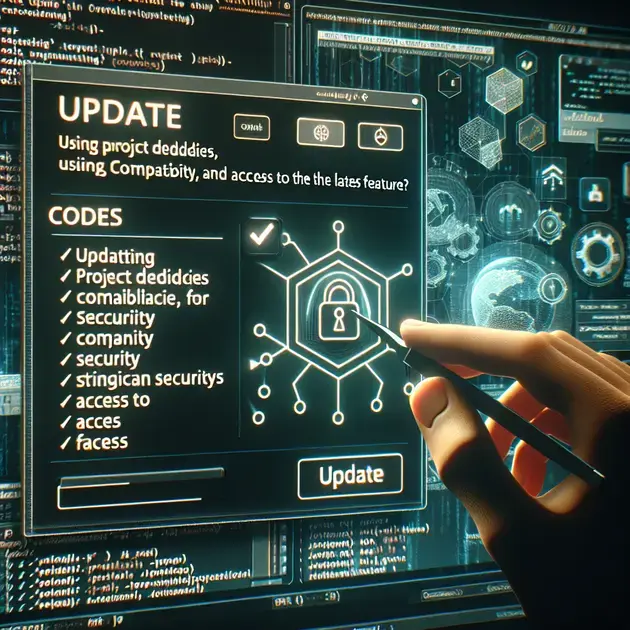Keeping your packages up to date is crucial to the success and security of your project. With the constant evolution of technology, regularly updating your dependencies ensures that your project remains compatible with the latest features and functionalities.
One efficient way to maintain your packages is by using npm update command. This command allows you to easily update all the dependencies listed in your package.json file to their latest versions, helping you to stay current with the ever-changing landscape of software development.

**
Keeping Your Dependencies Current with npm update**
Introduction
Keeping your dependencies current is essential for the smooth functioning of your project. npm update is a powerful tool that can help you achieve this goal effortlessly. By updating your packages regularly, you not only get access to the latest features but also ensure the security and stability of your project.
Step 1: Check for Outdated Packages
The first step in keeping your dependencies current is to check for outdated packages. You can do this by running the command `npm outdated` in your terminal. This will provide you with a list of packages that have newer versions available.
Step 2: Update All Packages
Once you have identified the outdated packages, you can update them by running the command `npm update`. This will automatically update all packages to their latest versions. Make sure to review any warnings or errors that may appear during the update process.
Step 3: Update Specific Packages
If you only want to update specific packages, you can do so by running the command `npm update package-name`. This will update the specified package to the latest version while leaving other packages untouched.
Step 4: Update Global Packages
In addition to project-specific packages, you may also have global packages that need to be updated. You can update global packages by using the `-g` flag, like `npm update -g package-name`.
Conclusion
By following these simple steps and regularly updating your dependencies with npm update, you can ensure that your project stays up to date with the latest features and remains compatible with updated packages.
**
Stay Up to Date with the Latest Features**
Introduction
Staying up to date with the latest features is crucial for staying competitive in today’s fast-paced technology landscape. By keeping your dependencies current and updating your packages regularly, you can take advantage of new features and improvements that can enhance the functionality of your project.
Step 1: Subscribe to Release Notes
One way to stay informed about the latest features is to subscribe to the release notes of the packages you use. This way, you will be notified whenever a new version is released, along with the new features and improvements it brings.
Step 2: Follow Official Blogs and Social Media
Many software projects have official blogs and social media accounts where they announce new features and updates. By following these channels, you can stay up to date with the latest developments and ensure that you are not missing out on any important features.
Step 3: Join Community Forums and Discussion Groups
Community forums and discussion groups are great places to interact with other developers and stay informed about the latest trends in the industry. By participating in these forums, you can learn about new features, best practices, and upcoming releases.
Step 4: Experiment with Beta Versions
If you are eager to try out the latest features before they are officially released, you can opt to use beta versions of packages. This will give you a sneak peek at upcoming features and allow you to provide feedback to the developers.
Conclusion
By staying up to date with the latest features and continuously updating your packages, you can ensure that your project remains innovative and competitive in the ever-evolving tech industry.
**
Ensuring Compatibility with Updated Packages**
Introduction
Ensuring compatibility with updated packages is crucial for the overall functionality and performance of your project. By following best practices and guidelines, you can prevent compatibility issues and maintain a seamless development process.
Step 1: Review Release Notes and Changelogs
Before updating any package, it is essential to review the release notes and changelogs to understand what has changed from the previous version. This will help you identify any breaking changes or compatibility issues that may affect your project.
Step 2: Perform Thorough Testing
After updating your packages, it is important to perform thorough testing to ensure that everything is working as expected. This includes running automated tests, manual checks, and user acceptance testing to validate the compatibility of the updated packages.
Step 3: Use Version Locking
To prevent compatibility issues, you can use version locking to specify the exact versions of packages that your project depends on. This will ensure that only compatible versions are installed, reducing the risk of conflicts and breaking changes.
Step 4: Engage with the Community
If you encounter compatibility issues with updated packages, don’t hesitate to engage with the community for help. Many developers face similar challenges, and by seeking advice and sharing experiences, you can find solutions to ensure compatibility with updated packages.
Conclusion
By following these steps and best practices, you can ensure compatibility with updated packages and avoid any disruptions to your project. Keeping your dependencies current and prioritizing compatibility will lead to a smoother development process and a more stable application.

Keeping Your Dependencies Current with npm update
Keeping your dependencies up to date is essential in order to ensure that your project is running smoothly and securely. One of the ways to do this in a Node.js project is by using npm update. This command allows you to update all the dependencies listed in your package.json file to their latest versions.
To update your dependencies with npm update, simply open your terminal, navigate to your project directory, and run the command ‘npm update’. npm will then check for any newer versions of your dependencies and update them accordingly.
By regularly updating your dependencies, you not only ensure that your project is using the latest features and improvements but also that any security vulnerabilities in older versions are patched. This can help prevent potential issues and keep your project secure.
It’s important to note that after running npm update, you should also test your project to ensure that everything is still functioning correctly. Sometimes updates can introduce breaking changes that may require adjustments in your code.
In conclusion, using npm update to keep your dependencies current is a best practice in Node.js development. By staying up to date with the latest versions of your dependencies, you can enjoy improved performance, security, and compatibility in your project.
Stay Up to Date with the Latest Features
Staying up to date with the latest features in the technology world is crucial for any developer. In the context of Node.js development, this means keeping your dependencies current with the most recent updates and releases. By doing so, you can take advantage of new features, enhancements, and optimizations that can improve the functionality and performance of your project.
npm update is a powerful tool that allows you to easily update your project dependencies to their latest versions. By regularly running this command, you can ensure that you are always leveraging the newest capabilities offered by the packages you rely on.
Updating your dependencies not only gives you access to the latest features but also helps you stay competitive in the rapidly evolving tech landscape. By embracing new technologies and improvements, you can enhance your development skills and deliver better solutions to your clients and users.
When you stay up to date with the latest features, you also demonstrate to potential employers or collaborators that you are committed to continuous learning and growth in your field. This can open up new opportunities and establish you as a forward-thinking professional in the industry.
In conclusion, staying current with the latest features by updating your dependencies is key to staying relevant and competitive in the fast-paced world of technology. By embracing change and innovation, you can position yourself for success and continued growth in your development career.
Ensuring Compatibility with Updated Packages
Ensuring compatibility with updated packages is a critical aspect of maintaining a stable and functional project. When new versions of dependencies are released, they may come with changes that could affect how they interact with other parts of your application. By updating your packages regularly, you can address any compatibility issues and ensure that everything works smoothly together.
npm update helps you stay on top of compatibility concerns by automatically updating your project’s dependencies to their latest versions. This can help prevent conflicts between different packages and ensure that your project remains cohesive and functional.
Compatibility issues can arise when you least expect them, causing unexpected errors or malfunctions in your application. By proactively updating your dependencies and checking for compatibility, you can avoid these pitfalls and maintain a reliable project environment.
Regularly checking for compatibility with updated packages also allows you to take advantage of new features and improvements while mitigating any risks associated with outdated or conflicting dependencies. This proactive approach can save you time and effort in troubleshooting issues down the line.
In conclusion, ensuring compatibility with updated packages through tools like npm update is crucial for the stability and performance of your project. By staying proactive and addressing compatibility concerns early on, you can establish a solid foundation for your development work and avoid potential headaches in the future.
Conclusion
In the dynamic world of Node.js development, keeping your dependencies current using tools like npm update is paramount. By regularly updating your dependencies, you not only ensure that your project runs smoothly and securely but also stay in sync with the latest features and improvements.
Staying up to date with the latest features is more than just a trend; it’s a necessity for developers to remain competitive. By embracing new technologies and enhancements, you can enhance your skills, deliver superior solutions, and position yourself as a forward-thinking professional in the industry.
Ensuring compatibility with updated packages is a crucial step in maintaining a stable and functional project. By proactively addressing compatibility issues, you can prevent conflicts, avoid unexpected errors, and create a reliable project environment that fosters growth and innovation.